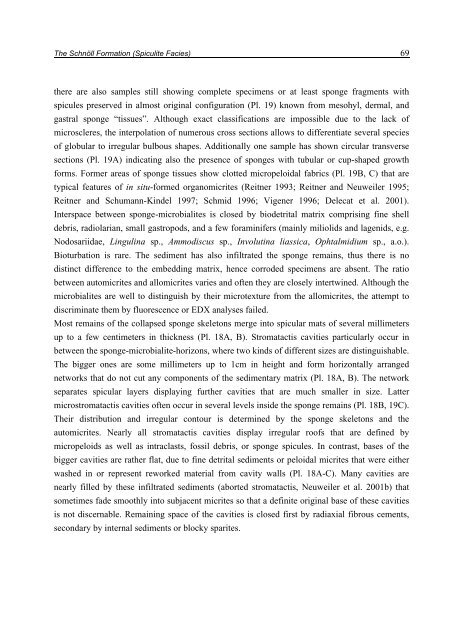Porifera-microbialites of the Lower Liassic (Northern Calcareous ...
Porifera-microbialites of the Lower Liassic (Northern Calcareous ...
Porifera-microbialites of the Lower Liassic (Northern Calcareous ...
You also want an ePaper? Increase the reach of your titles
YUMPU automatically turns print PDFs into web optimized ePapers that Google loves.
The Schnöll Formation (Spiculite Facies) 69<br />
<strong>the</strong>re are also samples still showing complete specimens or at least sponge fragments with<br />
spicules preserved in almost original configuration (Pl. 19) known from mesohyl, dermal, and<br />
gastral sponge “tissues”. Although exact classifications are impossible due to <strong>the</strong> lack <strong>of</strong><br />
microscleres, <strong>the</strong> interpolation <strong>of</strong> numerous cross sections allows to differentiate several species<br />
<strong>of</strong> globular to irregular bulbous shapes. Additionally one sample has shown circular transverse<br />
sections (Pl. 19A) indicating also <strong>the</strong> presence <strong>of</strong> sponges with tubular or cup-shaped growth<br />
forms. Former areas <strong>of</strong> sponge tissues show clotted micropeloidal fabrics (Pl. 19B, C) that are<br />
typical features <strong>of</strong> in situ-formed organomicrites (Reitner 1993; Reitner and Neuweiler 1995;<br />
Reitner and Schumann-Kindel 1997; Schmid 1996; Vigener 1996; Delecat et al. 2001).<br />
Interspace between sponge-<strong>microbialites</strong> is closed by biodetrital matrix comprising fine shell<br />
debris, radiolarian, small gastropods, and a few foraminifers (mainly miliolids and lagenids, e.g.<br />
Nodosariidae, Lingulina sp., Ammodiscus sp., Involutina liassica, Ophtalmidium sp., a.o.).<br />
Bioturbation is rare. The sediment has also infiltrated <strong>the</strong> sponge remains, thus <strong>the</strong>re is no<br />
distinct difference to <strong>the</strong> embedding matrix, hence corroded specimens are absent. The ratio<br />
between automicrites and allomicrites varies and <strong>of</strong>ten <strong>the</strong>y are closely intertwined. Although <strong>the</strong><br />
<strong>microbialites</strong> are well to distinguish by <strong>the</strong>ir microtexture from <strong>the</strong> allomicrites, <strong>the</strong> attempt to<br />
discriminate <strong>the</strong>m by fluorescence or EDX analyses failed.<br />
Most remains <strong>of</strong> <strong>the</strong> collapsed sponge skeletons merge into spicular mats <strong>of</strong> several millimeters<br />
up to a few centimeters in thickness (Pl. 18A, B). Stromatactis cavities particularly occur in<br />
between <strong>the</strong> sponge-microbialite-horizons, where two kinds <strong>of</strong> different sizes are distinguishable.<br />
The bigger ones are some millimeters up to 1cm in height and form horizontally arranged<br />
networks that do not cut any components <strong>of</strong> <strong>the</strong> sedimentary matrix (Pl. 18A, B). The network<br />
separates spicular layers displaying fur<strong>the</strong>r cavities that are much smaller in size. Latter<br />
microstromatactis cavities <strong>of</strong>ten occur in several levels inside <strong>the</strong> sponge remains (Pl. 18B, 19C).<br />
Their distribution and irregular contour is determined by <strong>the</strong> sponge skeletons and <strong>the</strong><br />
automicrites. Nearly all stromatactis cavities display irregular ro<strong>of</strong>s that are defined by<br />
micropeloids as well as intraclasts, fossil debris, or sponge spicules. In contrast, bases <strong>of</strong> <strong>the</strong><br />
bigger cavities are ra<strong>the</strong>r flat, due to fine detrital sediments or peloidal micrites that were ei<strong>the</strong>r<br />
washed in or represent reworked material from cavity walls (Pl. 18A-C). Many cavities are<br />
nearly filled by <strong>the</strong>se infiltrated sediments (aborted stromatactis, Neuweiler et al. 2001b) that<br />
sometimes fade smoothly into subjacent micrites so that a definite original base <strong>of</strong> <strong>the</strong>se cavities<br />
is not discernable. Remaining space <strong>of</strong> <strong>the</strong> cavities is closed first by radiaxial fibrous cements,<br />
secondary by internal sediments or blocky sparites.

















